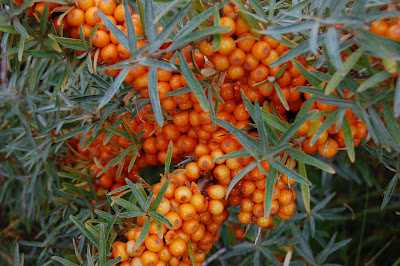So I'm going to do all twelve on here and then I'll pick my favourite three to hand in for the assignment. Catherine went through all twelve of the plants, mainly fruiting plants, giving brief descriptions of them and their benefits. During this time we also sampled Catherine's damson gin and quince jelly.
Greg then appeared to take our Phytology lecture, he took us through the different terminology and identification for leaves and stems of plants. We then had a stomp around the gardens.
It's more expensive and time-consuming for the plant to make female rather than male "parts" - some plants, like the one below, make one female "part" and surround it by males.
The soft-spiky fruit is the female (picture one), the female surrounded by male flowers (picture two).
Colletia spinosissima
Picture one: small, clustered pale flowers, that smell of magnolia.
Picture two: Fleshy-looking spines, they're hard and dangerous, to protect the plant against predator attack.
Leaf with leaflets, toothed-edge.
Pre-historic plants, they have thick waxy leaves, and have cyanide components to stop predators from eating them. They adapted for the dinosaurs, and because the adaption was beneficial the plants never redeveloped.
Medlars. Member of the apple family, five star leaf shape on the top of the medlar is the same as the five star leaf shape on the bottom of an apple.
Cultivated variety of the yarrow, which has changed the petal colour from pale cream/white to pale pink.
Each "leaf" is seperate but attached to a whole. Opening up one leaf, they're all folded over each other, protecting the seed (female) inside.
Stomping around the gardens - random photos.
Last photo - Bella Donna - plants tell you what they are designed for, this plant is poisonous, but in Elizabethen times eyedroplets were used to dilate female's pupils to make their eyes look more sparkly - the black droplets look like dilated pupils.
Dissection kits and our dissection time! Pulling apart and studying flowers, roots, leaves and fruits.
In the afternoon, we went wild harvesting to Gullane with Catherine and Heather - our aim was to collect some sea buckthorn, rosehips, hawthorn berries and if possible some elderberries. Gullane is out in East Lothian, on the coast, about a 30-45 minute drive down the A1.
The area is rich in sea buckthorn, originally brought up from the south of England and it has run wild over the area, strange as the east coast is significantly colder than the west, however there seems to be a nice pocket of weather over Gullane which will encourage the sea buckthorns growth.
The berries are high in beta-carotene, hence their orange/yellow colour, the berries have to be frozen to be removed from the stem, otherwise they just burst. They're full of juice and a single hard pip, which you spit out. They've got a bitter citrus taste - sweetened they would be an bareable taste.
Rosehips. Picking them when a ruby red colour, the berries need frosted before they can be used. The rosehip is full of hard seeds, they're an external fruit casing.
Hawthown Berries. Dark red berries, high in anthocyanins, grow in clusters, pastey texture under a waxy skin.
We also saw when we were stomping around:
Yarrow.
Blackberry.
Blackberry flowers.
Bittersweet - very poisonous berry.






































sophie, i think your blog is awesome! its really informative :)
ReplyDeleteBlimey, my yard is full of poisonous berries. But I've been taught since I was old enough to go outside never to eat any berries or mushrooms.
ReplyDeleteHave no fear, all will be cut back to the ground in late fall.